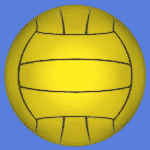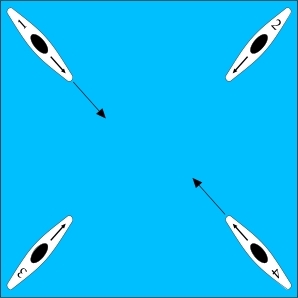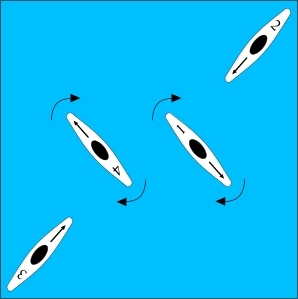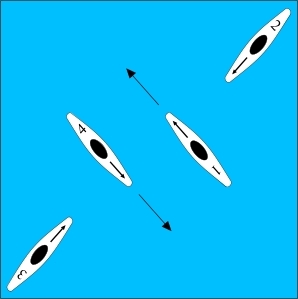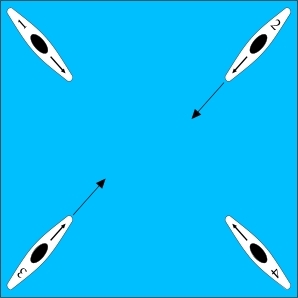Canoe Polo Skills and Drills
Contents
Throwing tips and drills
Power
'Flick' practice
Ball control-hands
Throwing drill for judging distance
Boat skill drills
Stern pivot square
Passing and shooting drills
Lucky Pierre
Catch and shoot star
Pass and move
Break drill
Here are a few skills training drills and some tips on throwing.
I haven't included some of the square drills we've done during Leam training yet, because unless everyone can catch and pass accurately, the ball inevitably ends out of the square, needs to be retrieved and we all get cold and bored waiting!
There's more to come. Until then, use your imagination and make up drills that practice your weaknesses. Remember to practice everything on both sides!
Throwing tips and drills
Power
Here are some throwing tips that I was given for getting maximum power:
- Start with your body 'wound up' and unwind in the sequence:
-
- Shoulders
- Upper arm
- Lower arm
- Wrist flick
- Keep your elbow high, ie around shoulder height.
- At the end of the throw, release the ball with a wrist flick, trying to eliminate all spin. Practise this by throwing the ball softly at first, to just get the wrist part right.
See this video of a good throw by what looks like a dutch geezer: http://www.vimeo.com/1494848.
Below are two drills that I like, courtesy of the Baron.
Flick practice
Hopefully this drill will help you get the final wrist flick part of the throw right, so energy isn't wasted with the ball spinning off the fingers.
1) Sit (preferably in a boat on the water) opposite another player, not too far away. Hold the ball with your upper arm horizontal (ie at shoulder level) and your arm bent at 90o-ish. Throw the ball to eachother ten times using just a small 'flicking' movement like Bruce Lee's one inch punch.
2) Now move further apart and throw the ball to eachother five times using the full movement.
3) Repeat!
Ball control - hands
Hopefully this drill will help you get a feel for catching the ball one handed in a controlled manner and throwing the ball without gripping it too hard (if the ball has to escape your grip to start flying, then speed is being taken off it.)
1) Sit (preferably in a boat on the water) opposite another player, not too far away. Throw the ball fairly softly to the other person, in an area described by an imaginary upside down horse-shoe around their head so that they can get the ball with one hand. They catch it and throw it back in one movement, in a soft way such that their hand matches speed with the ball as it comes in, moves back with the ball while slowing it down then throws it back without having to stop or grip the ball hard.
2) Carry on this 'to-and-fro' until you're bored.
Throwing drill for judging distance
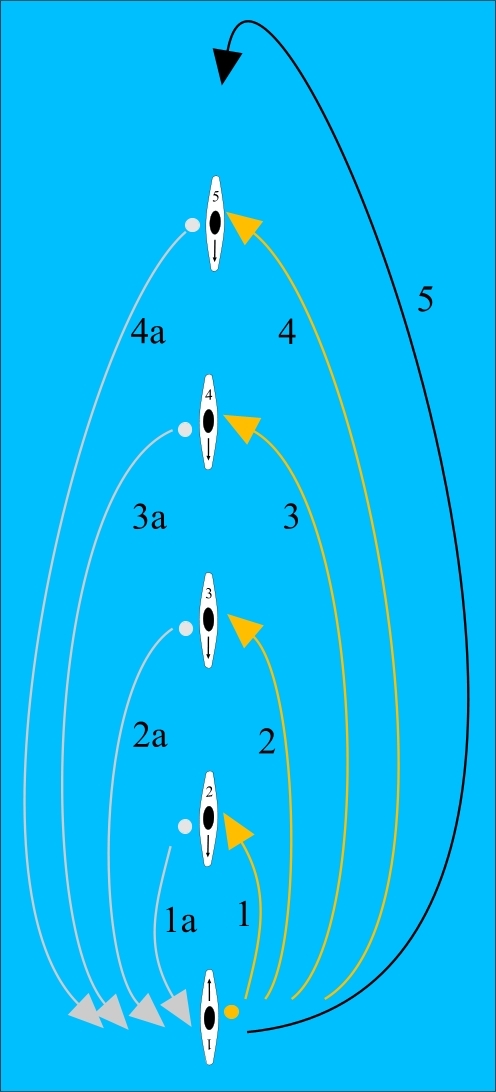
A drill to make practising long throws a bit quicker.
- Player 1 passes to player 2, then player 2 passes back (1a).
- Player 1 passes to player 3, then player 3 passes back.
- Player 1 passes to player 4, then player 4 passes back.
- Player 1 passes to player 5, then player 5 passes back.
- Player 1 sprints to the end to sit behind player 5, facing player 2. Everyone shifts down and player 2 turns and becomes the thrower. Repeat.
Boat skill drills
Stern pivot square
|
1)Players one and four sprint to the middle and pass to each other. |
2) Both players perform a fast stern pivot to face the corner they started from. |
|
3) Having made their turn, both players return to their original corner and get ready for their next turn. |
4) The drill now repeats, with players two and three sprinting to the middle. |
Passing and shooting drills
Lucky Pierre
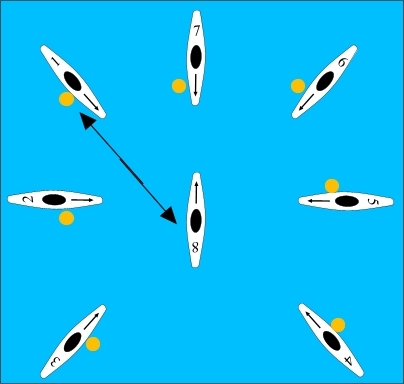
This drill is to be done at speed, so each player in the outer ring has a ball to prevent delays from bad passes/catches. Alternatively, one ball can be used and after catching it is passed to the next person round who then throws it back, and so on.
Player one passes their ball to player eight, who then passes it back. Player two passes their ball to eight and, who then passes it back, and so on, moving round the star. When player eight passes the ball back to player seven, everyone moves round one place, ie seven becomes eight, eight becomes one, one becomes two and so on. Repeat!
NB: Hard passes are worth a go, if you get used to receiving hard passes, nice friendly passes are dead simple. Don't be offended, consider a hard pass to your face a challenge (as long as you are expecting it, if not, why weren't you looking!)
Catch and shoot star
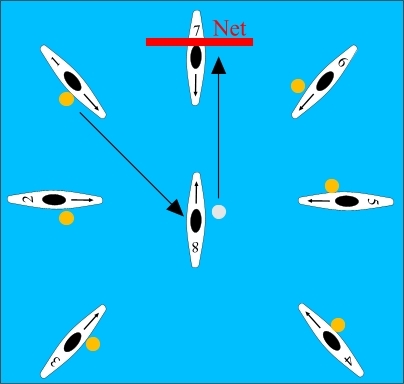
To keep the drill going, players one to six should have a ball each. Player seven is the goal-keeper.
Player one passes his ball to player eight, player eight shoots. Player two passes his ball to player eight, player eight shoots, and so on, moving round the star. When all balls have been shot, everyone moves round one place, ie seven becomes eight, eight becomes one, one becomes two and so on. Repeat!
NB: Always try to aim your shots at top corners, or make them awkward to save some other way, try to trick the keeper with the power. As I have found, blasting the ball straight at the keepers paddles sounds nice, but is fairly ineffective!
Pass and move
No pictures for this one, but it's good, especially for a warm-up and wake-up exercise. Just keep moving around into space, looking for a pass.
- Keep passes straight to hands.
- Make sure your passes aren't intercepted.
- If the ball goes loose, paddle your nuts or other appendages off to get it back/steal it off someone.
- If someone isn't looking and they reasonably should be (ie don't throw it at them if they momentarily have their back turned), chuck it at them. Always be looking!
Break drill
This drill is for practicing the sprinting, timing and ball skills used during a 'break'. By a break, I mean that your team has just regained possession and players have broken free to sprint up the pitch and receive a long pass, hopefully resulting in a goal. The three pictures below should explain it!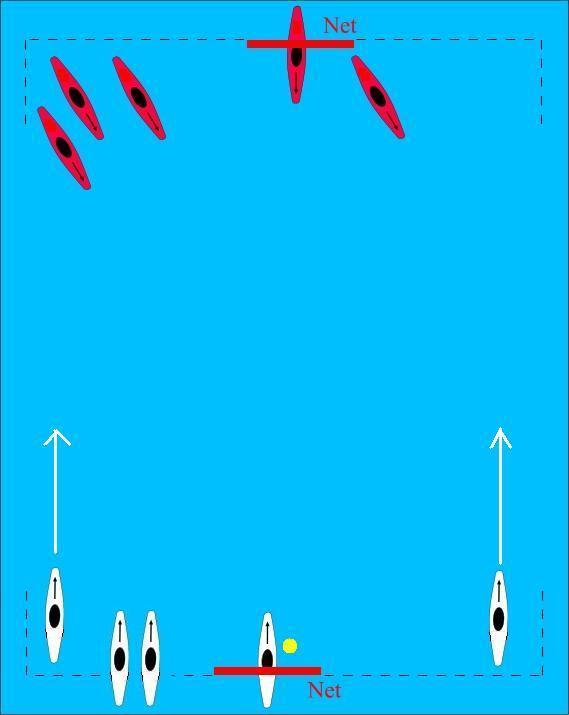
Two players and the keeper of the attacking team line up on the goal line. The opposing team has just a keeper and one defender. The two attacking players on the wings sprint up the pitch.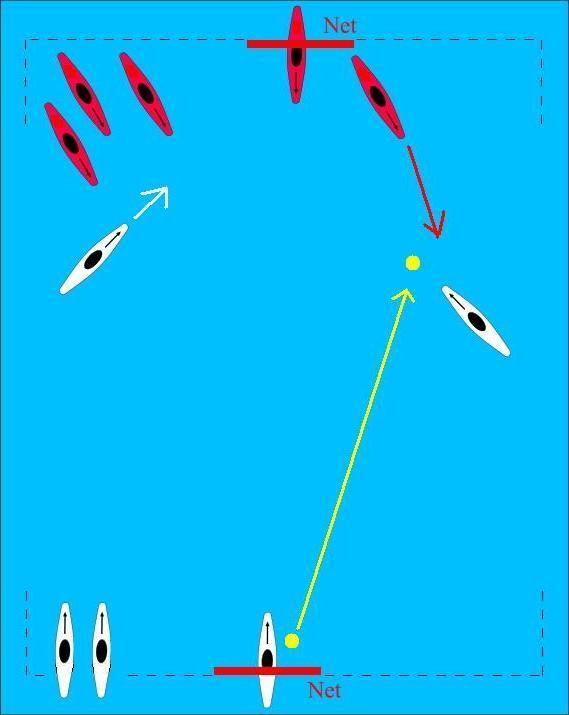
The attacking players start to sprint in towards goal. The attacking keeper either throws a long pass to or in front of one of his the players. The defender sprints to stop the player with the ball.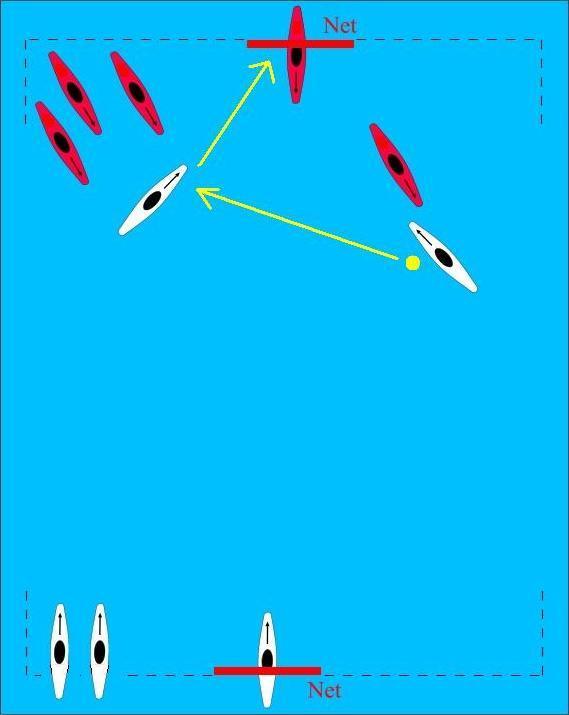
The attacking player with the ball, having drawn the defender across, passes the ball to the other attacking player, who then shoots. GOAL! Maybe...
Now the three reds left over become the attackers and the two whites left over become the defenders. And repeat!
- If you are the attackers who are breaking free you need to go at your sprinting with all the bestial vigour of a hungry cheetah. If you can't manage that, training is the answer! You need to sprint down the sides, then angle in towards goal to receive a pass. A pass is much easier to take from the side than over your head.
- If you are the attacking keeper, your throw needs to be well timed and accurate so your man can pick it up. Don't overestimate how far you can throw.
- If you are attacker receiving the ball from the keeper, don't overestimate how far your keeper can throw. You need to gather the pass from the keeper, draw the defender, but get rid of the ball while the pass is still easy to make. The pass must be accurate and probably to hands.
- If you are the shooter, you need to line up on goal so you can just catch the ball and shoot, without much further paddling.


